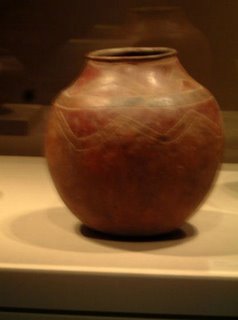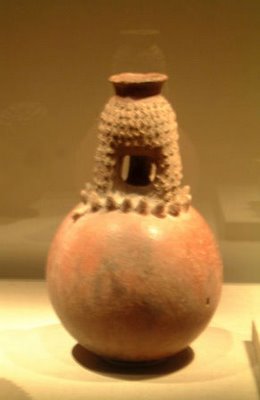Keith Achepohl collection of African pottery

Born in 1934, Keith Achepohl is currently the head of the printmaking Dept. at the University of Iowa -- and somewhere along the way he collected a lot of African pottery.

As he tells it, he began his collection while traveling through Africa.
Dealers would pull up their trucks at the markets and he would go through their stuff -- looking for the unusual, the extraordinary. That's the kind of collection it is -- based less on historical authenticity and more on what looks interesting. So the museum's official title of this exhibit, "For Hearth and Altar", is somewhat misleading. It should be called "For fun viewing".

There's a good-natured, swinging goofiness about many of these things -- like those
neighborhood brass bands that proliferate in some not-yet-industrialized countries around the world -- and I can understand why Mr. Archepohl says he sold his collection of contemporary American pottery when he discovered these engaging objects, most (but not all) of which also contemporary, i.e. mid to late 20th Century.

I'd like to put some of the large jars side-by-side with the 16th Century Japanese jars (also in the Art Institute) that are so similar in size/shape/color -- but feel so different -- as they reflect an intellectual choice to be simple/natural that goes back to the Taoist philosphers of the 4th century BCE.
It's also interesting to see Mr. Achepohl's own graphics -- as they reflect the disastrous consequence of academic modernism on the European pictorial tradition: - failing as both design, picture, and engaging expression -- even if pleasant enough for a dentist's waiting room.
I'd also like to note that although the musuem's brochure tells us that these "often surprising ceramic vessels have been created for domestic and ritual uses" -- there's
no documentation to that effect -- and it's quite likely that since most of them are less than 50 years old, many of them were made for the collector's market -- which would, of course, in the twisted art-philosophy of the art museum, disqualify them as art objects worthy of their collection. One may also note that not a single potter is identified by name -- although if it really counted - i.e. -- if name were important to value like it is in the post Renaissance European tradition, inquiries could have been made -- the artists, or at least their children/grandchildren are still living -- and some artists could have been identified. But that would have removed them from their mythic state of anonymity - and probably revealed that the artist did, occasionally, make things for sale to dealers. (who wouldn't jump at the chance of making some money?)
So the contemporary tribal artist is honored as such only as long as he remains
anonymous. Once known -- he's no longer an artist at all -- he's just a manufacturer of trinkets for tourists and street fairs in places like Chicago or Atlanta.


0 Comments:
Post a Comment
<< Home